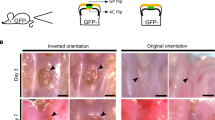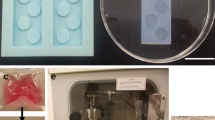Summary
This communication describes a new experimental model for the study of the role of the extracellular matrix (ECM) in morphogenesis. In a preceding paper (Markson et al. 1991) we demonstrated that isolated epiphyses from femora of 6-day-old chick embryos grow during the first days in organ culture almost as well as their intact counterparts. Heating femora for 1 h at 45.2° C caused complete cessation of growth and proteoglycan biosynthesis. When the cut surface of a heat-inactivated (HI) epiphysis was brought into apposition with the cut surface of a live epiphysis and the attached pair placed in organ culture, the HI epiphysis began to grow and reached almost the same size as its live partner. The different possible interpretations of this finding are discussed. When a HI epiphysis of a certain shape (from humerus) is attached to a live epiphysis of a very different shape (from femur) and the attached pair is cultured for 6–7 days, the typical resumption of growth can be observed and the HI epiphysis that doubled or tripled its size retains its original characteristic form. The possibility that the existing infrastructure of the cartilaginous ECM directs the pattern of deposition of newly synthesized ECM by the chondroblasts is discussed, and it is suggested that stretch-activated channels participate in a process by which cells sense the topography of their ECM.
Similar content being viewed by others
References
Archer CW, Rooney P (1989) Cell and matrix interactions in cartilage morphogenesis. Prog Zool 35:202–204
Bard J (1990) Morphogenesis. Cambridge University Press, Cambridge
Birk DE, Trelstad RL (1985) Fibroblasts create compartments in extracellular space where collagen polymerizes into fibrils and fibrils associate into bundles. Ann NY Acad Sci 460:258–266
Birk DE, Zycband EI, Winkelmann DA, Trelstad RL (1989) Collagen fibrillogenesis in situ: Fibril segments are intermediates in matrix assembly. Proc Natl Acad Sci USA 86:4549–4553
Harris AK, Stopack D, Wild P (1981) Fibroblast traction as a mechanism for collagen morphogenesis. Nature 290:249–251
Hay ED, Svoboda KK (1989) Extracellular matrix interaction with the cytoskeleton. In: Stein WD, Bronnet F (eds) Cell shape. Academic Press, New York, pp 147–172
Howlett AR, Bissell MJ (1990) Regulation of mammary epithelial cell function: a role for stromal and basement membrane matrices. Protoplasma 159:85–95
Kim JJ, Conrad HE (1977) Properties of cultured chondrocytes obtained from histologically distinct zones of the chick embryo tibiotarsus. J Biol Chem 252:8292–8299
Markson Y, Weiss DW, Doljanski F (1991) Growth and proteoglycan metabolism of chick embryonic long bone rudiments and of isolated epiphyses. Rouxs Arch Dev Biol 200:202–207
Rooney P, Archer C, Wolpert L (1984) Morphogenesis of cartilaginous long bone rudiments. In: Trelstad RL (ed) The role of extracellular matrix in development, 42nd Symp Soc Dev Biol. AR Liss, New York, pp 305–322
Sachs F (1989) Ion channels as mechanical transducers. In: Stein WD, Bronnet F (eds) Cell shape. Academic Press, New York, pp 63–92
Sengel P, Manger A, Robert 7, Kieny M (1985) Extracellular matrix in skin morphogeneis. UCLA Symp. Mol Cellular Biol [New Ser] 31:319–347
Stopak D, Wessells NK, Harris AK (1985) Morphogenetic rearrangement of injected collagen in developing chicken limb buds. Proc Natl Acad Sci USA 82:2804–2808
Author information
Authors and Affiliations
Additional information
Offprint requests to: F. Doljanski
Rights and permissions
About this article
Cite this article
Markson, Y., Weiss, D.W. & Doljanski, F. Resumption of growth of heat inactivated embryonic epiphyses by grafting. Roux's Arch Dev Biol 200, 208–212 (1991). https://doi.org/10.1007/BF00361339
Received:
Accepted:
Issue Date:
DOI: https://doi.org/10.1007/BF00361339




